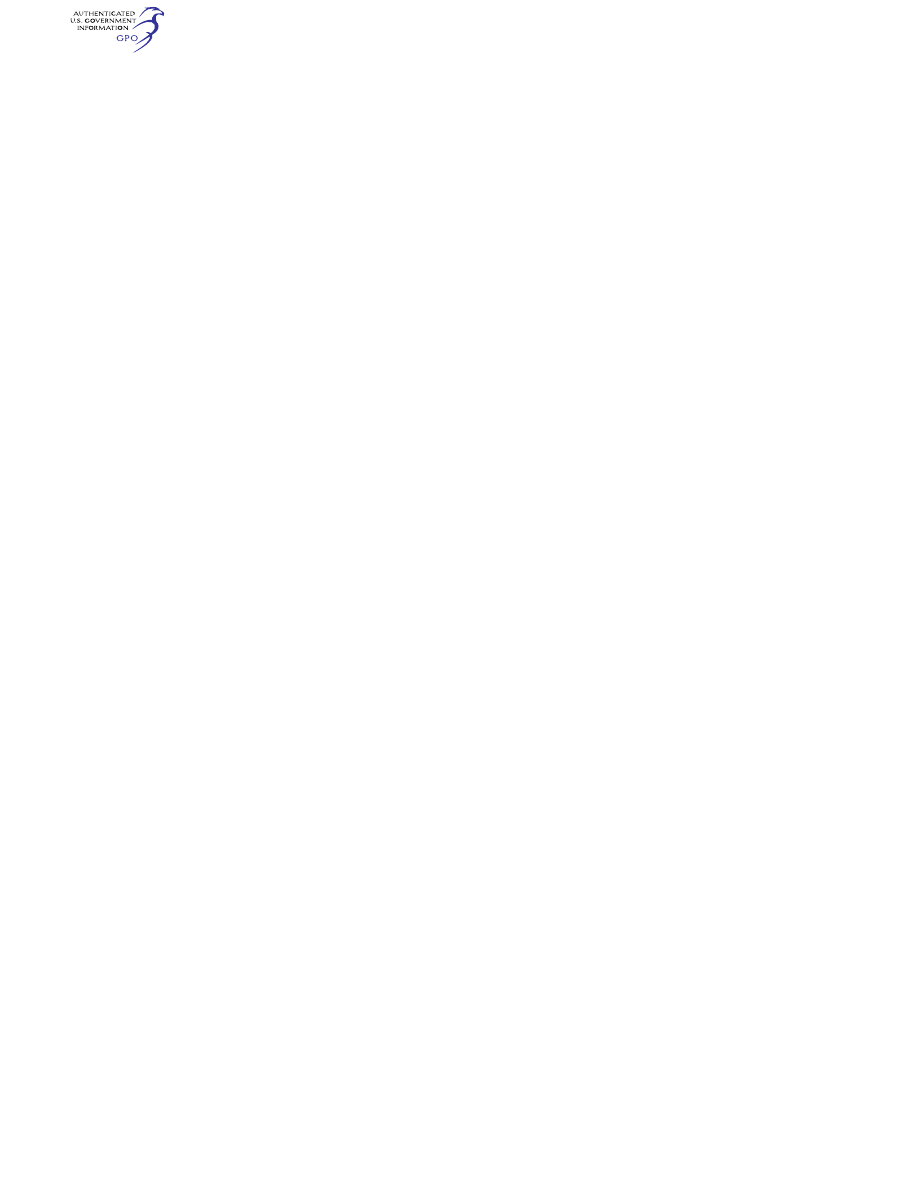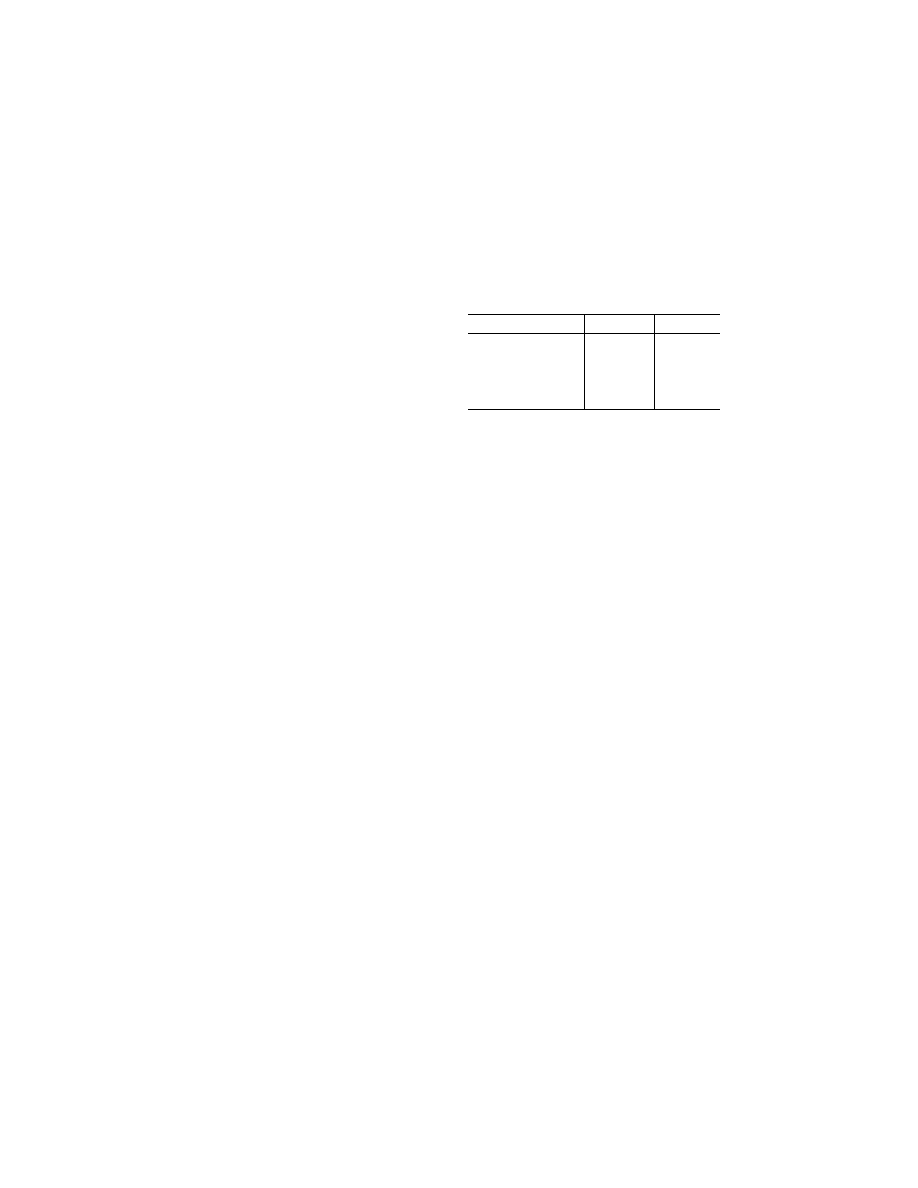
902
14 CFR Ch. I (1–1–24 Edition)
Pt. 185
PART 185—TESTIMONY BY EMPLOY-
EES AND PRODUCTION OF
RECORDS IN LEGAL PRO-
CEEDINGS, AND SERVICE OF
LEGAL PROCESS AND PLEAD-
INGS
Sec.
185.1
Purpose.
185.3
Acceptance of service on behalf of the
Secretary of Transportation or the Ad-
ministrator.
185.5
Testimony by employees and produc-
tion of records in legal proceedings.
A
UTHORITY
: 49 U.S.C. 106(g), 40113–40114,
46104; 49 CFR part 9.
S
OURCE
: Docket No. 9900, 34 FR 16622, Oct.
17, 1969, unless otherwise noted.
§ 185.1 Purpose.
(a) The purpose of this part is to
name the FAA officials who, pursuant
to part 9 of the regulations of the Of-
fice of the Secretary of Transportation
(49 CFR part 9) as amended (34 FR
11972, July 16, 1969), are those:
(1) Upon whom legal process or plead-
ings may be served in any legal pro-
ceeding concerning the FAA, and who
have authority to acknowledge the
service and take further action there-
on; and
(2) Who otherwise perform the func-
tions prescribed by part 9 in legal pro-
ceedings concerning the FAA with re-
spect to testimony by FAA employees
and production of FAA records in legal
proceedings.
(b) For purposes of this part, ‘‘legal
proceedings’’ includes any proceeding
before a court of law, administrative
board or commission, hearing officer,
or other body conducting a legal or ad-
ministrative proceeding.
§ 185.3 Acceptance of service on behalf
of the Secretary of Transportation
or the Administrator.
Legal process or pleadings in any
legal proceeding concerning the FAA
may be served, at the option of the
server, on the Chief Counsel, Deputy
Chief Counsel, Assistant Chief Counsel,
Litigation Division, of the FAA, or any
other FAA official designated by the
Chief Counsel, with the same effect as
if served upon the Secretary of Trans-
portation or the Administrator. The of-
ficial accepting the service under this
section acknowledges the service and
takes further action as appropriate.
§ 185.5 Testimony by employees and
production of records in legal pro-
ceedings.
The Chief Counsel, and each Assist-
ant Chief Counsel, each Regional Coun-
sel, the Aeronautical Center Counsel,
and the Technical Center Counsel, with
respect to matters arising within their
respective jurisdictions, and any other
FAA official designated by the Chief
Counsel, perform the functions in legal
proceedings (other than one described
in § 185.3 of this part) as prescribed by
part 9 of the regulations of the Office of
the Secretary of Transportation, with
respect to testimony by FAA employ-
ees and production of FAA records in
legal proceedings.
[Doc. No. 9900, 34 FR 16622, Oct. 17, 1969, as
amended by Amdt. 185–1, 54 FR 39296, Sept.
25, 1989; Amdt. 185–3, 62 FR 46866, Sept. 4,
1997]
PART 187—FEES
Sec.
187.1
Scope.
187.3
Definitions.
187.5
Duplicates of licenses.
187.7
Copies; seal.
187.15
Payment of fees.
187.17
Failure of applicant to pay prescribed
fees.
187.51
Applicability of overflight fees.
187.53
Calculation of overflight fees.
187.55
Overflight fees billing and payment
procedures.
A
PPENDIX
A
TO
P
ART
187—M
ETHODOLOGY FOR
C
OMPUTATION OF
F
EES FOR
C
ERTIFICATION
S
ERVICES
P
ERFORMED
O
UTSIDE
THE
U
NITED
S
TATES
A
PPENDIX
B
TO
P
ART
187 [R
ESERVED
]
A
PPENDIX
C
TO
P
ART
187—F
EES FOR
P
RODUC
-
TION
C
ERTIFICATION
-R
ELATED
S
ERVICES
P
ERFORMED
O
UTSIDE THE
U
NITED
S
TATES
A
UTHORITY
: 31 U.S.C. 9701; 49 U.S.C. 106(f),
106(g), 106(l)(6), 40104–40105, 40109, 40113–40114,
44702, 45301.
S
OURCE
: Docket No. 8347, 32 FR 12051, Aug.
22, 1967, unless otherwise noted.
§ 187.1 Scope.
This part prescribes fees only for
FAA services for which fees are not
prescribed in other parts of this chap-
ter or in 49 CFR part 7. The fees for
services furnished in connection with
making information available to the

903
Federal Aviation Administration, DOT
§ 187.51
public are prescribed exclusively in 49
CFR part 7. Appendix A to this part
prescribes the methodology for com-
putation of fees for certification serv-
ices performed outside the United
States. Appendix C to this part pre-
scribes the methodology for computa-
tion of fees for production certifi-
cation-related services performed out-
side the United States.
[Docket FAA–2015–3597, Amdt. 187–36, 81 FR
85853, Nov. 29, 2016]
§ 187.3 Definitions.
For the purpose of this part:
Great circle distance
means the short-
est distance between two points on the
surface of the Earth.
Overflight
means a flight through
U.S.-controlled airspace that does not
include a landing in or takeoff from the
United States.
Overflight through Enroute airspace
means an overflight through U.S.-con-
trolled airspace where primarily radar-
based air traffic services are provided.
Overflight through Oceanic airspace
means an overflight through U.S.-con-
trolled airspace where primarily proce-
dural air traffic services are provided.
U.S.-controlled airspace
means all air-
space over the territory of the United
States, extending 12 nautical miles
from the coastline of U.S. territory;
any airspace delegated to the United
States for U.S. control by other coun-
tries or under a regional air navigation
agreement; or any international air-
space, or airspace of undetermined sov-
ereignty, for which the United States
has accepted responsibility for pro-
viding air traffic control services.
[Docket FAA–2015–3597, Amdt. 187–36, 81 FR
85853, Nov. 29, 2016]
§ 187.5 Duplicates of licenses.
The fee for furnishing to a person en-
titled thereto a replacement, duplicate,
or facsimile of a certificate or other
document evidencing a license, for
which a fee is not specifically provided
elsewhere in this chapter, is $2.
§ 187.7 Copies; seal.
The fees for furnishing photostatic or
similar copies of documents and for af-
fixation of the seal for a certification
or validation are the same as those
provided in subpart H of 49 CFR part 7.
§ 187.15 Payment of fees.
(a) The fees of this part are payable
to the Federal Aviation Administra-
tion by check, money order, wire trans-
fers, draft, payable in U.S. currency
and drawn on a U.S. bank, or by credit
card payable in U.S. currency, prior to
the provision of any service under this
part.
(b) Applicants for the FAA services
provided under this part shall pay any
bank processing charges on fees col-
lected under this part, when such
charges are assessed on U.S. Govern-
ment.
(c) Applicants for the FAA services
described in Appendix A of this part
shall pay bank processing charges,
when such charges are assessed by
banks on U.S. Government deposits.
(d) The fees described in appendix B
of this part are payable to the Federal
Aviation Administration in U.S. cur-
rency. Remittance of fees of $1,000 or
more are to be paid by electronic funds
transfer. Remittance of amounts less
than $1,000 may be paid by electronic
funds transfer, check, money order,
credit card, or draft.
[Doc. No. 27809, 60 FR 19631, Apr. 19, 1995, as
amended by Amdt. 187–7, 62 FR 13503, Mar. 20,
1997; Amdt. 187–7, 62 FR 23295, Apr. 29, 1997;
Amdt. 187–10, 62 FR 55703, Oct. 27, 1997; Amdt.
187–7, 63 FR 40000, July 24, 1998; Amdt. 187–11,
65 FR 36008, June 6, 2000; Amdt. 187–12, 66 FR
43718, Aug. 20, 2001; Amdt. 187–4, 72 FR 18559,
Apr. 12, 2007]
§ 187.17 Failure by applicant to pay
prescribed fees.
If an applicant fails to pay fees
agreed to under appendix C of this part,
the FAA may suspend or deny any ap-
plication for service and may suspend
or revoke any production certification-
related approval granted.
[Doc. No. 28967, 62 FR 55703, Oct. 27, 1997]
§ 187.51 Applicability of overflight
fees.
(a) Except as provided in paragraphs
(c) or (d) of this section, any person
who conducts an overflight through ei-
ther Enroute or Oceanic airspace must
pay a fee as calculated in § 187.53.

904
14 CFR Ch. I (1–1–24 Edition)
§ 187.53
(b)
Services.
Persons covered by para-
graph (a) of this section must pay a fee
for the FAA’s rendering or providing of
certain services, including but not lim-
ited to the following:
(1) Air traffic management.
(2) Communications.
(3) Navigation.
(4) Radar surveillance, including sep-
aration services.
(5) Flight information services.
(6) Procedural control.
(7) Emergency services and training.
(c) The FAA does not assess a fee for
any military or civilian overflight op-
erated by the United States Govern-
ment or by any foreign government.
(d) Fees for overflights through U.S.-
controlled airspace covered by a writ-
ten FAA agreement or other binding
arrangement are charged according to
the terms of that agreement or ar-
rangement unless the terms are silent
on fees.
[Docket FAA–2015–3597, Amdt. 187–36, 81 FR
85853, Nov. 29, 2016]
§ 187.53 Calculation of overflight fees.
(a) The FAA assesses a total fee that
is the sum of the Enroute and Oceanic
calculated fees.
(1)
Enroute fee.
The Enroute fee is cal-
culated by multiplying the Enroute
rate in paragraph (c) of this section by
the total number of nautical miles
flown through each segment of Enroute
airspace divided by 100 (because the
Enroute rate is expressed per 100 nau-
tical miles).
(2)
Oceanic fee.
The Oceanic fee is cal-
culated by multiplying the Oceanic
rate in paragraph (c) of this section by
the total number of nautical miles
flown through each segment of Oceanic
airspace divided by 100 (because the
Oceanic rate is expressed per 100 nau-
tical miles).
(b) Distance flown through each seg-
ment of Enroute or Oceanic airspace is
based on the great circle distance
(GCD) from the point of entry into
U.S.-controlled airspace to the point of
exit from U.S.-controlled airspace
based on FAA flight data. Where actual
entry and exit points are not available,
the FAA will use the best available
flight data to calculate the entry and
exit points.
(c) The rate for each 100 nautical
miles flown through Enroute or Oce-
anic airspace is:
Time period
Enroute rate
Oceanic rate
January 1, 2017 to January
1, 2018 ...........................
58.45
23.15
January 1,2018 to January
1, 2019 ...........................
60.07
24.77
January 1, 2019 and Be-
yond ...............................
61.75
26.51
(d) The formula for the total over-
flight fee is:
Rij = E*DEij/100 + O*DOij/100
Where:
Rij = the total fee charged to aircraft flying
between entry point i and exit point j.
DEij = total distance flown through each
segment of Enroute airspace between
entry point i and exit point j.
DOij = total distance flown through each
segment of Oceanic airspace between
entry point i and exit point j.
E and O = the Enroute and Oceanic rates, re-
spectively, set forth in paragraph (c) of
this section.
(e) The FAA will review the rates de-
scribed in this section at least once
every 2 years and will adjust them to
reflect the current costs and volume of
the services provided.
[Docket FAA–2015–3597, Amdt. 187–36, 81 FR
85853, Nov. 29, 2016]
§ 187.55 Overflight fees billing and
payment procedures.
(a) The FAA will send an invoice to
each user when fees are owed to the
FAA. If the FAA cannot identify the
user, then an invoice will be sent to the
registered owner. Users will be billed at
the address of record in the country
where the aircraft is registered, unless
a billing address is otherwise provided.
(b) The FAA will send an invoice if
the monthly (based on Universal Co-
ordinated Time) fees equal or exceed
$400.
(c) Payment must be made by one of
the methods described in § 187.15(d).
[Docket FAA–2015–3597, Amdt. 187–36, 81 FR
85853, Nov. 29, 2016]

905
Federal Aviation Administration, DOT
Pt. 187, App. A
A
PPENDIX
A
TO
P
ART
187—M
ETHOD
-
OLOGY FOR
C
OMPUTATION OF
F
EES
FOR
C
ERTIFICATION
S
ERVICES
P
ER
-
FORMED
O
UTSIDE
THE
U
NITED
S
TATES
(a) Fixed fees and hourly rates have been
derived using the methodology described
below to ensure full cost recovery for certifi-
cation actions or approvals provided by the
FAA for persons outside the United States.
(b) These rates are based on aviation safety
inspector time rather than calculating a sep-
arate rate for managerial or clerical time be-
cause the inspector is the individual per-
forming the actual service. Charging for in-
spector time, while building in all costs into
the rate base, provides for efficient cost re-
covery and time management.
(c) The hourly billing rate has been deter-
mined by using the annual operations budget
of the Flight Standards Service. The budget
is comprised of the following:
(1) Personnel compensation and benefits,
budget code series 1100 (excluding codes 1151
and 1152—overtime, Sunday and holiday
pay), 1200, and 1300.
(2) Travel and transportation of persons,
budget code series 2100 (excluding code 2100—
site visit travel).
(3) Transportation of things, budget code
series 2200.
(4) Rental, communications, utilities,
budget code series 2300.
(5) Printing and reproduction, budget code
series 2400.
(6) Contractual services, budget code series
2500.
(7) Supplies and materials, budget code se-
ries 2600.
(8) Equipment, budget code series 3100.
(9) Lands and structures, budget code se-
ries 3200.
(10) Insurance claims and indemnities,
budget code series 4200.
(d) In order to recover overhead costs at-
tributable to the budget, all costs other than
direct inspector transportation and subsist-
ence, overtime, and Sunday/holiday costs,
are assigned to the number of inspector posi-
tions. An hourly cost per inspector is devel-
oped by dividing the annual Flight Stand-
ards Operations Budget, excluding the items
enumerated above, by the number of avia-
tion safety inspections (OMB position series
1825) on board at the beginning of the fiscal
year, to determine the annual cost of an
aviation safety inspector. This annual cost
of an aviation safety inspector is divided by
2,087 hours, which is the annual paid hours of
a U.S. Federal Government employee. This
result in the hourly government paid cost of
an aviation safety inspector.
(e) To ensure that the hourly inspector
cost represents a billing rate that ensures
full recovery of costs, the hourly cost per in-
spector must be multiplied by an indirect
work factor to determine the hourly inspec-
tor billing rate. This is necessary for the fol-
lowing reasons:
(1) Inspectors spend a significant amount
of time in indirect work to support their in-
spection activities, much of which cannot be
allocated to any one client.
(2) Not all 2,087 annual paid hours are
available as work hours because training,
providing technical assistance, leave, and
other indirect work activities reduce the
work time that may be directly billed. Con-
sequently, the hourly cost per inspector
must be adjusted upwards by an indirect
work factor. The calculation of an indirect
work factor is discussed in paragraph (f) of
this appendix.
(f)(1) The indirect work factor is deter-
mined using the following formula:
1
1
1
+
+ =
∑
a
b
i
k
(
)
indirect work factor
where:
a = indirect work rate, and
b = leave usage (total leave hours divided by
total hours available for work.
(2) The components of the formula are de-
rived as follows:
(i)
a = indirect work rate.
Indirect work rate
is take from the Flight Standards Staffing
Standard Order and is used to project the
amount of time an aviation safety inspector
spends in indirect activities, as opposed to
certification and surveillance work. The in-
direct work activities are:
(A) Development of master minimum
equipment lists on Flight Operations Evalua-
tion Board.
(B) Development of aircraft training docu-
ments on Flight Standardization Board.
(C) Development of Maintenance program
documents on Maintenance Review Board.
(D) Providing technical assistance.
(E) Assisting legal counsel.
(F) Evaluation of technical documents.
(G) Leave (all types).
(H) Training.
(I) Administrative time.
(J) Travel for indirect work.

906
14 CFR Ch. I (1–1–24 Edition)
Pt. 187, App. C
(ii)
b = leave usage (total leave hours divided
by total hours available for work).
This is com-
puted by using OMB guidelines of 280 average
annual leave hours and 1,800 average annual
hours available for work for computer man-
power requirements.
(g) The hourly inspector cost, when multi-
plied by the indirect work factor, yields the
hourly inspector billing rate and ensures full
cost recovery by incorporating the total
amount of FAA paid hours needed to produce
one hour of direct billable inspector time.
(h) Certifications and approvals for which
there are fixed times, such as airman tests,
are determined by multiplying the time used
in the Flight Standards Staffing Standard or
airman test guidelines by the inspector hour-
ly billing rate.
(i) Certifications and approvals for which
there are no fixed work rates, such as airman
and repair station facilities (air agencies),
are billed at the hourly inspector billing
rate.
(j) Actual transportation and subsistence
expenses incurred in certification or ap-
proval actions will be billed in addition to
the hourly inspector billing rate, where such
expenses are incurred.
(k) In no event will the fees exceed the ac-
tual costs of providing certification or ap-
proval services.
(l) The methodology for computing user
fees is published in this Appendix. The User
fee schedule is published in an FAA Advisory
Circular entitled ‘‘Flight Standards Service
Schedule of Charges Outside the United
States.’’ A copy of this publication may be
obtained from: New Orders, Superintendent
of Documents, P.O. Box 371954, Pittsburgh,
PA 15250–7954.
(m) Fees will be reviewed every year, at
the beginning of the fiscal year, and adjusted
either upward or downward in order to re-
flect the current costs of performing tests,
authorizations, certifications, permits, or
ratings.
(n) Notice of each change to a fee for a
service described in the user fee schedule
will be published in the ‘‘Notices’’ section of
the F
EDERAL
R
EGISTER
.
[Amdt. 187–5, 60 FR 19631, Apr. 19, 1995]
A
PPENDIX
B
TO
P
ART
187 [R
ESERVED
]
A
PPENDIX
C
TO
P
ART
187—F
EES
FOR
P
RODUCTION
C
ERTIFICATION
-R
E
-
LATED
S
ERVICES
P
ERFORMED
O
UT
-
SIDE THE
U
NITED
S
TATES
(a)
Purpose.
This appendix describes the
methodology for the calculation of fees for
production certification-related services out-
side the United States that are performed by
the FAA.
(b)
Applicability.
This appendix applies to
production approval holders who elect to use
manufacturing facilities or supplier facilities
located outside the United States to manu-
facture or assemble aeronautical products
after September 30, 1997.
(c)
Definitions.
For the purpose of this ap-
pendix, the following definitions apply:
Manufacturing facility
means a place where
production of a complete aircraft, aircraft
engine, propeller, part, component, or appli-
ance is performed.
Production certification-related service
means
a service associated with initial production
approval holder qualification; ongoing pro-
duction approval holder and supplier surveil-
lance; designee management; initial produc-
tion approval holder qualification and ongo-
ing surveillance for production certificate
extensions outside the United States; con-
formity inspections; and witnessing of tests.
Supplier facility
means a place where pro-
duction of a part, component, or sub-
assembly is performed for a production ap-
proval holder.
Production approval holder
means a person
who holds an FAA approval for production
under type certificate only, an FAA approval
for production under an approved production
inspection system, a production certificate,
a technical standard order authorization, or
a parts manufacturer approval.
(d)
Procedural requirements.
(1) Applicants
may apply for FAA production certification-
related services provided outside the United
States by a letter of application to the FAA
detailing when and where the particular
services are required.
(2) The FAA will notify the applicant in
writing of the estimated cost and schedule to
provide the services.
(3) The applicant will review the estimated
costs and schedule of services. If the appli-
cant agrees with the estimated costs and
schedule of services, the applicant will pro-
pose to the FAA that the services be pro-
vided. If the FAA agrees and can provide the
services requested, a written agreement will
be executed between the applicant and the
FAA.
(4) The applicant must provide advance
payment for each 12-month period of agreed
FAA service unless a shorter period is agreed
to between the Production Approval Holder
and FAA.
(e)
Fee determination.
(1) Fees for FAA pro-
duction certification-related services will
consist of: personnel compensation and ben-
efit (PC&B) for each participating FAA em-
ployee, actual travel and transportation ex-
penses incurred in providing the service,
other agency costs and an overhead percent-
age.
(2) Fees will be determined on a case-by-
case basis according to the following general
formula:
W
1
H
1
+ W
2
H
2
etc., + T + O
Where:

907
Federal Aviation Administration, DOT
§ 189.3
W
1
H
1
= hourly PC&B rate for employee 1,
times estimated hours
W
2
H
2
= hourly PC&B rate for employee 2,
etc., times estimated hours
T = estimated travel and transportation ex-
penses
O = other agency costs related to each activ-
ity including overhead.
(3) In no event will the applicant be
charged more than the actual FAA costs of
providing production certification-related
services.
(4) If the actual FAA costs vary from the
estimated fees by more than 10 percent, writ-
ten notice by the FAA will be given to the
applicant as soon as possible.
(5) If FAA costs exceed the estimated fees,
the applicant will be required to pay the dif-
ference prior to receiving further services. If
the estimated fees exceed the FAA costs, the
applicant may elect to apply the balance to
future agreements or to receive a refund.
(f) Fees will be reviewed by the FAA peri-
odically and adjusted either upward or down-
ward in order to reflect the current costs of
performing production certification-related
services outside the United States.
(1) Notice of any change to the elements of
the fee formula in this Appendix will be pub-
lished in the F
EDERAL
R
EGISTER
.
(2) Notice of any change to the method-
ology in this Appendix and other changes for
the fees will be published in the F
EDERAL
R
EGISTER
.
[Doc. No. 28967, 62 FR 55703, Oct. 27, 1997]
PART 189—USE OF FEDERAL AVIA-
TION ADMINISTRATION COMMU-
NICATIONS SYSTEM
Sec.
189.1
Scope.
189.3
Kinds of messages accepted or relayed.
189.5
Limitation of liability.
A
UTHORITY
: 31 U.S.C. 9701; 49 U.S.C. 106(g),
40104, 40113, 44502, 45303.
S
OURCE
: Docket No. 27778, 60 FR 39615, Aug.
2, 1995, unless otherwise noted.
§ 189.1 Scope.
This part describes the kinds of mes-
sages that may be transmitted or re-
layed by FAA Flight Service Stations.
§ 189.3 Kinds of messages accepted or
relayed.
(a) Flight Service Stations may ac-
cept for transmission over FAA com-
munication systems any messages con-
cerning international or overseas air-
craft operations described in para-
graphs (a) (1) through (6) of this sec-
tion. In addition, Flight Service Sta-
tions may relay any message described
in this section that was originally ac-
cepted for transmission at an FAA
Flight Service Station outside the 48
contiguous States, or was received
from a foreign station of the Aero-
nautical Fixed Telecommunications
Network that, in normal routing,
would require transit of the United
States to reach an overseas address:
(1) Distress messages and distress
traffic.
(2) Messages concerning the safety of
human life.
(3) Flight safety messages con-
cerning—
(i) Air traffic control, including—
(A) Messages concerning aircraft in
flight or about to depart;
(B) Departure messages;
(C) Flight plan departure messages;
(D) Arrival messages;
(E) Flight plan messages;
(F) Flight notification messages;
(G) Messages concerning flight can-
cellation; and
(H) Messages concerning delayed de-
parture;
(ii) Position reports from aircraft;
(iii) Messages originated by an air-
craft operating agency of immediate
concern to an aircraft in flight or
about to depart; and
(iv) Meteorological advice of imme-
diate concern to an aircraft in flight or
about to depart.
(4) Meteorological messages con-
cerning—
(i) Meteorological forecasts;
(ii) Meteorological observations ex-
clusively; or
(iii) Other meteorological informa-
tion exchanged between meteorological
offices.
(5) Aeronautical administrative mes-
sages—
(i) Concerning the operation or main-
tenance of facilities essential to the
safety or regulatory of aircraft oper-
ation;
(ii) Essential to efficient functioning
of aeronautical telecommunications; or
(iii) Between civil aviation authori-
ties concerning aircraft operation.
(6) Notices to airmen.
(b) The following messages may only
be relayed through the FAA commu-
nications systems:





